Water ice may seem to stand still, but that is far from what happens on the microscale. In the 1930s, entropy measurements, which give an account of the degree of disorder or randomness in a material, of water ice found that even at the lowest measured temperatures, there is still a choice of an exponential number of configurations of the O-H bonds. This is because, while the oxygen atoms in ice form a perfect crystal, the arrangement of the hydrogen atoms remains ambiguous. Each of the hydrogen atoms is bound strongly to one oxygen atom by a covalent bond, and more loosely to another one, helping keep molecules together in a crystal. The only constraint on how this may happen is that each oxygen must have two strongly bound neighbours out of four to form an H2O molecule (see the left side of the diagram below for a drawing of a possible H configuration). Even with this strong constraint, there are still a huge number of possibilities open, resulting in large low-temperature entropy.
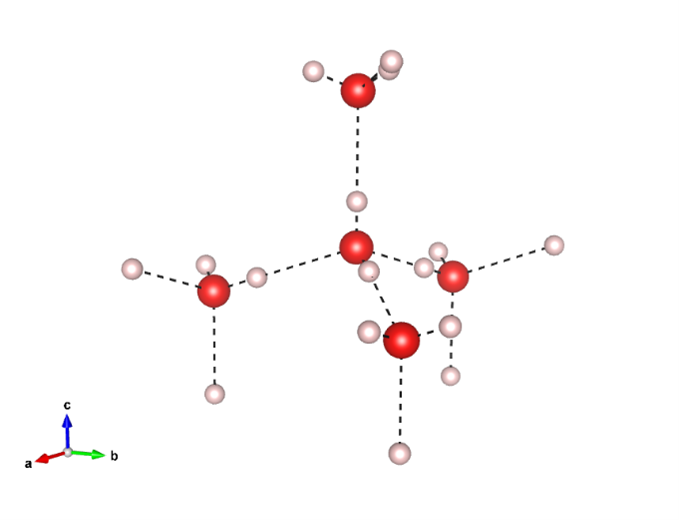
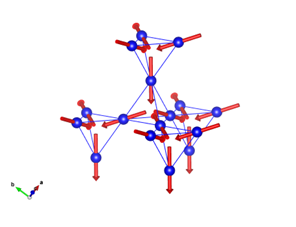
Figure above: Comparison between a possible configuration of water-ice (left) and spin-ice (right).
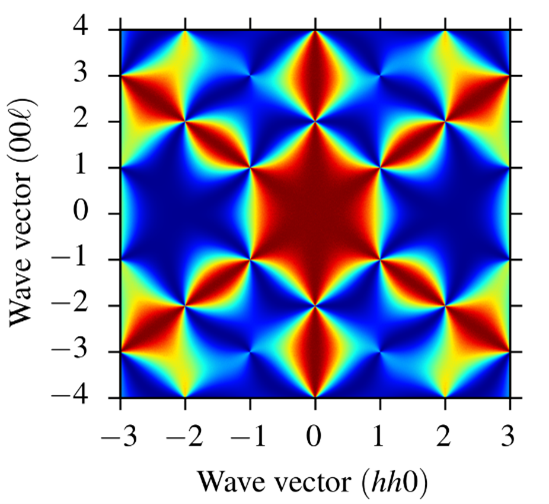
Magnetic systems known as spin ices also show similar behaviour but, this time, the disorder comes from magnetic moments rather than chemical bonds. In pyrochlore materials, such as Dy2Ti2O7, spins form tetrahedra that join at their corners.
Each spin can point from one tetrahedron into the other, and the interaction between them only requires each tetrahedron to have two spins pointing in, and two out. Like water ice, this is not enough to constrain the spins to a unique pattern and instead they fluctuate between many possible configurations. In a neutron-scattering experiment, this behaviour is shown by pinch points forming a distinctive bow-tie pattern, as shown on the right. Seeing these points is a sign of long-range correlations between the spins, without any regular order.
Figure right: Simulation of diffuse neutron scattering from spin-ice showing pinch points characteristic of correlated disorder due to the ice rules.
This fluctuating background also allows the north and south poles of typical magnetic excitations to float apart, resulting in magnetic monopoles (the magnetic equivalent of an electrically charged particle) that cannot exist outside of such exotic materials.
Neutron-scattering experiments at ISIS have contributed greatly to our understanding of spin ice and other frustrated magnets, starting from the first observation of the diffuse scattering on PRISMA in the pyrochlore Ho2Ti2O7 to more complex and detailed experiments. Recently, the attention of the scientific community has been focused on finding similar states in materials with arrangements different from the tetrahedra observed in pyrochlores.
In a paper recently published in Physical Review Letters, a group of three ISIS scientists, led by Attila Szabó, theoretically explore spin-ice physics on a corner-sharing octahedron geometry. Attila holds the Keeley-Rutherford Fellowship, which is a joint position between the ISIS Facility and Oxford University (Wadham College) with the aim to provide theoretical support for neutron experiments.
The idea of looking into magnetic interaction on an octahedron geometry originated from a curiosity by Pascal Manuel and Fabio Orlandi about antiperovskite materials. These materials, in which magnetic atoms sit on the corners of octahedra, show various potential applications including negative thermal expansion, barocaloric effects, superionic conductivity, giant magnetoresistance and superconductivity to name but a few. While their geometry points to some possible strong frustration effects, it has been studied relatively little compared to pyrochlore systems.
The final realization that spin-ice physics was possible on an octahedral geometry occurred to Attila while working on an earlier project in collaboration with WISH Japanese users. In that piece of work, recently published in Physical Review Research, Attila was exploring, from a theoretical point of view, the ground state of CaFe3Ti4O12, where the corner sharing geometry of iron atoms was a possible explanation for the unusual ordering observed in the neutron data.
Following these intuitions and using simple 'toy' models with only short-range interactions, the team found a rich spin-ice physics including various phases that retain a large degree of disorder down to very low temperatures. Indeed, at one fine-tuned point in terms of magnetic interactions, a three-in-three-out arrangement is possible. This is the equivalent of the pyrochlore ice rule, but in the new octahedral geometry, and it also gives rise to the characteristic pinch points in the neutron scattering. One such configuration and the associated neutron scattering pattern are shown in the diagram below.
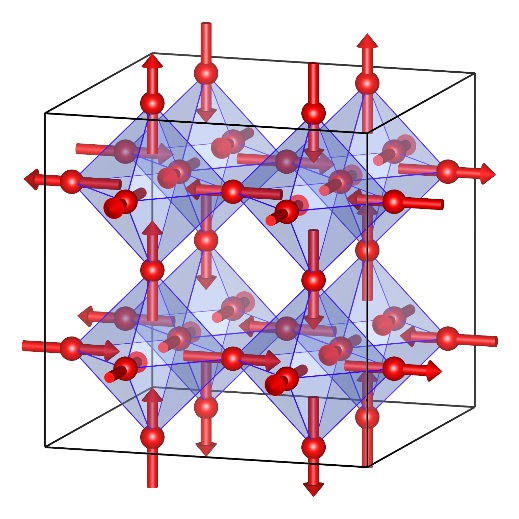
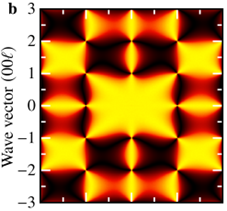
Figure above: (left) A 3-in 3-out arrangement in an octahedral topology and (right) diffuse neutron scattering showing pinch points.
In addition, spin-ice physics with large low-temperature entropy was seen for a wide range of parameters adjacent to this point. The group also showed this new kind of spin ice was present in more realistic models with long-range interactions, giving hope for finding this phase in real materials.
Currently the team is looking for signatures of these phases in rare-earth antiperovskite materials and in structural analogues, where the role of spin is played by the orientation of molecules inside the crystal, bringing them back close to where it all started, in the layout of molecules in ice.
Further information
The full paper can be found at: A. Szabó, F Orlandi and P. Manuel Fragmented Spin Ice and Multi-k Ordering in Rare-Earth Antiperovskites Phys. Rev. Lett. 129, 247201
Other relevant references:
Neutron-scattering experiments at ISIS related to spin ice and other frustrated magnets
- S. T. Bramwell et al. Spin Correlations in Ho2Ti2O7: A Dipolar Spin Ice System Phys. Rev. Lett. 87, 047205
- S. T. Bramwell et al. Spin Ice State in Frustrated Magnetic Pyrochlore Materials Science, 294, 1495
- J. A. M. Paddison et al. Suppressed-moment 2-k order in the canonical frustrated antiferromagnet Gd2Ti2O7, npj Quantum Materials, 6, 99
- S. T. Bramwell et al. Measurement of the charge and current of magnetic monopoles in spin ice Nature 461, 956
- S.R. Giblin et al. Pauling Entropy, Metastability, and Equilibrium in Dy2Ti2O7 Spin Ice Phys. Rev. Lett. 121, 067202
Antiperovskite materials:
- Y. Wang et al. Antiperovskites with Exceptional Functionalities Advanced Materials, 32, 1905007 (2019)
- L. Ding et al. Giant spontaneous exchange bias in an antiperovskite structure driven by a canted triangular magnetic structure Mater. Horiz., 6, 318-325
